How to Draw Circle From Middle Adobe
Honing your ability to describe faces and heads.
Whether you're drawing portraits or doodling cartoons, agreement how to sketch facial features will assist your piece of work. Learn more with this pace-past-step tutorial.
Drawing faces begins by understanding bones proportions.
Every artist struggles with sure aspects of anatomical cartoon. Heads and faces, with everything from eyelashes to cheekbones, tin can be particularly intimidating. There's a lot of crucial detail in every characteristic. Understanding the most bones proportions of the caput is central, and will pay dividends when you get to effectively details like the tip of the nose or the top of the ear.
Fortunately, learning these proportions is a very manageable task. Brainstorm by reducing the complexity of the human face to a few essential landmarks. Once y'all sympathise those basics, y'all can use them to your own drawings to create stunning portraiture or to fill up your latest sketchbook.
Found the landmarks of a human face.
When y'all observe a human being face, yous tin see that it'due south divided roughly into thirds from the hairline to the brow, the brow to the lesser of the nose (where it meets the very top of the philtrum), and the bottom of the nose to the bottom of the jaw. You can measure these distances on your own face and yous volition find them to be surprisingly similar. Dividing the face up into these thirds is a great place to brainstorm portrait cartoon.
Remember, the hairline is non the top of the head. The very top of the attic sits a picayune college than the hairline. Also notice that, from the profile or side view, the ear begins at about the halfway bespeak between the front of the forehead and the back of the head. A common mistake is to describe ears too far forward on the head. If you view them looking at the side of the head, you'll see ears beginning halfway back and go along moving backward from there.
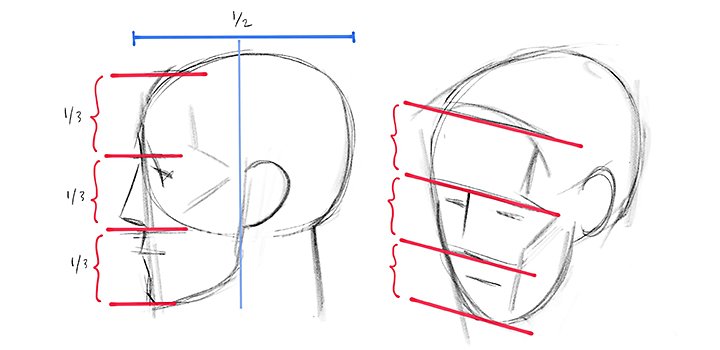
Step-by-step instructions for drawing faces.
To perfect your face-cartoon skills, follow this drawing tutorial. The more you practice this simple do, the more easily yous will be able to complete and make corrections to head drawings in the hereafter.
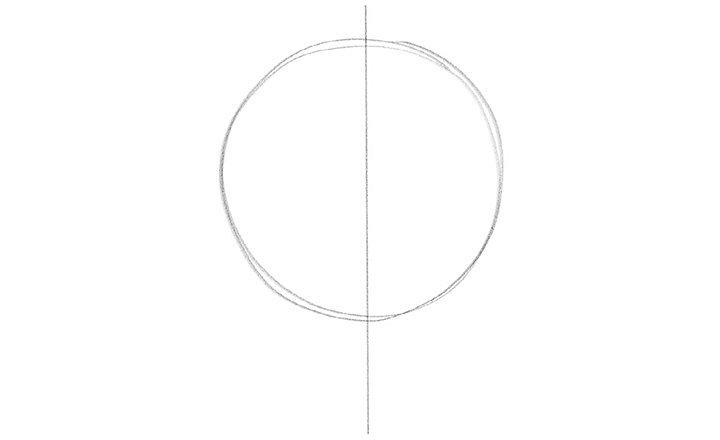
ane. Begin by drawing a simple circumvolve or oval shape. This is your head. Bisect information technology vertically, allowing the vertical line to driblet beneath the lesser of the circle.

two. Bisect the circle horizontally. This line will serve as the crude indication of the brow.

three. Sketch a horizontal line just under the meridian of the circumvolve to represent the hairline. Annotation the distance between the hairline and the brow line, and reproduce it twice more — moving downwardly — to create the thirds of the face. And so, draw two vertical lines that carve through the extreme left and correct boundaries of the circle, fishing slightly inwards from top to lesser (the pink lines in the image). These represent the side planes of the head.
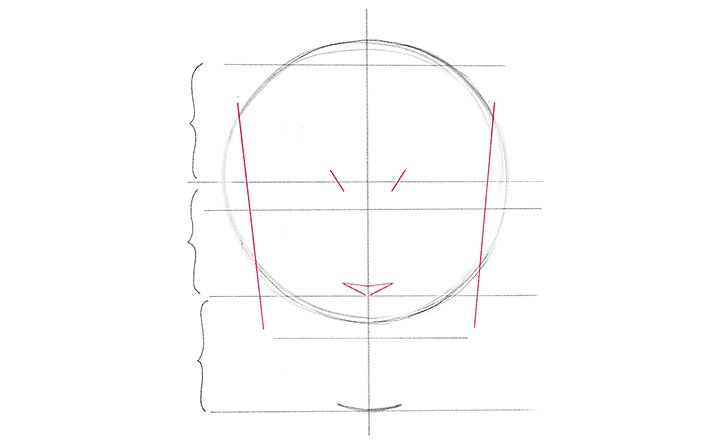
four. Describe the pink lines shown in this next illustration: two short diagonal lines, crossing through the brow line, moving inwards toward the centre from acme to bottom. Draw a compressed, inverted triangle representing the lesser aeroplane — the underside — of the nose.

v. Draw a horizontal line nigh one/4 the distance betwixt the forehead and the bottom of the olfactory organ, merely under the forehead line. This represents the eye line. Depict two more short diagonal lines — the pink lines, most the right and left extreme boundaries of the head. These lines movement outward, from top to lesser on either side, and represent the exterior edges of the ocular cavities — or the holes in the skull where the eyeballs reside, also known as middle sockets. Describe these diagonal lines betwixt the brow line and the newly placed eye line. They should finish within the left and right extreme borders of the head.
6. Traveling along the heart line, wait at the altitude between the newly fatigued diagonals and the vertical eye line of the face — the greenish vertical lines in the analogy. Bifurcate these distances with two vertical lines on either side of the face, equally shown by the bluish lines in the illustration. The line of the mouth is then fatigued about 1/iii of the way down between the bottom of the nose and the bottom of the jaw.
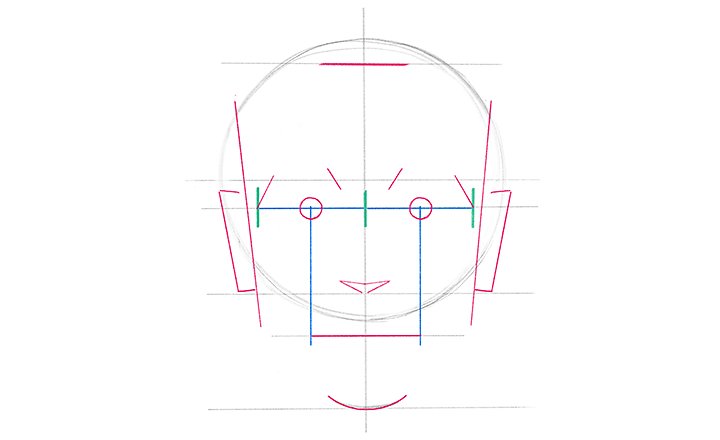
7. Yous now accept the precise locations for the corners of the rima oris and the center of the eyes' irises. Look at the circles that are drawn in the illustration to give yourself a rough thought of the correct size for drawing irises. The ears fall roughly betwixt the superlative of the eyes and the bottom of the nose.
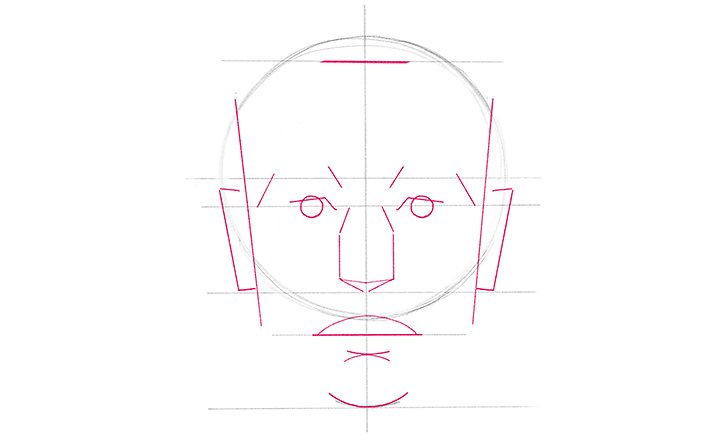
8. The line of the mouth gives you room to draw a shallow arc for the upper lip, likewise as the two opposite-facing short curvilinear lines for the bottom lip and the top of the ball of the chin. Add lines, as shown, for the structure of the nose. (These lines are meant to represent the farthermost left and correct boundaries of the nose, not the airplane of the bridge of the olfactory organ. As you lot will see in the examples of finished face drawings, the span is one of the features that is very specific to the individual, and at that place is no need to indicate it at this stage.)
9. Draw the lines for the upper lids of the optics. They should cut through the tops of the circles drawn for the irises of the eye. These lines should not be too narrow or broad. Expect carefully at their placement and proportions in the illustration.

10. Yous now have three proportional bases for face drawing. Use your own or feel free to copy this image and utilize it as a guide to trace over in Adobe Fresco to describe different faces. See the examples beneath, featuring dissimilar hairstyles and other features, for how the base can exist used.
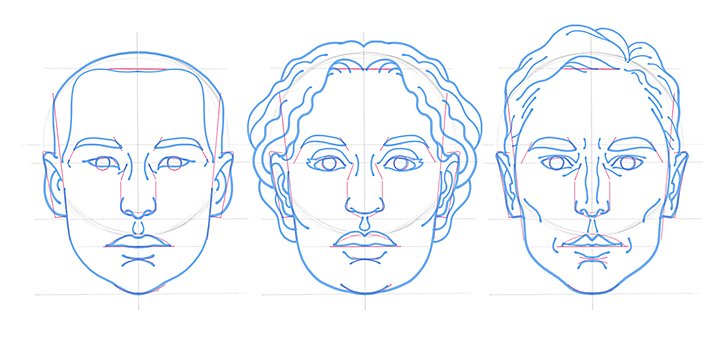
By making adjustments to the shapes of the eyes, the nose, the lips, and the jawline, equally well as to the thickness and angles of the eyebrows, you can draw whatever number of unique faces over this base. You can besides use these steps on dissimilar caput shapes to draw realistic faces or exaggerated caricatures, also as edit and revise faces you've fatigued that don't look quite right. And accept your skills even further by following along with many live drawing lessons on Behance.

knowlesniumor1936.blogspot.com
Source: https://www.adobe.com/sea/creativecloud/illustration/discover/how-to-draw-a-face.html
0 Response to "How to Draw Circle From Middle Adobe"
Post a Comment